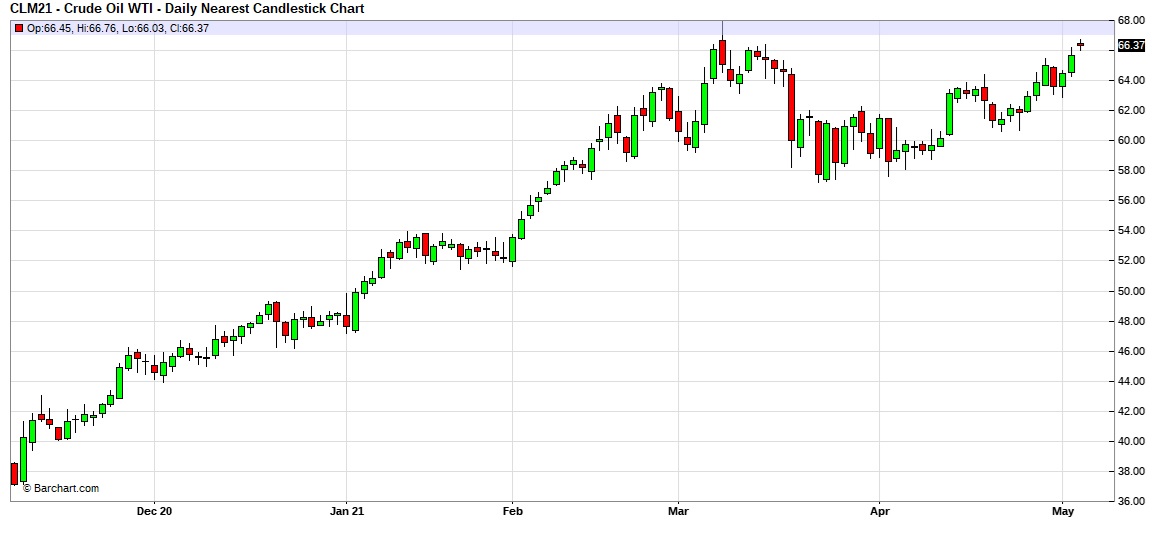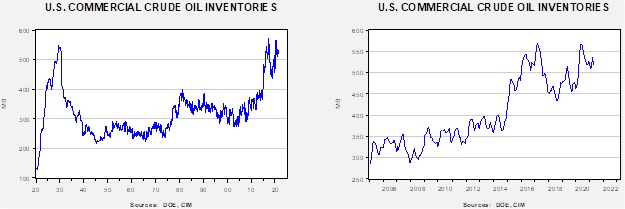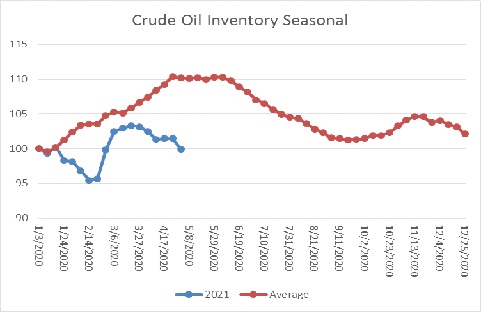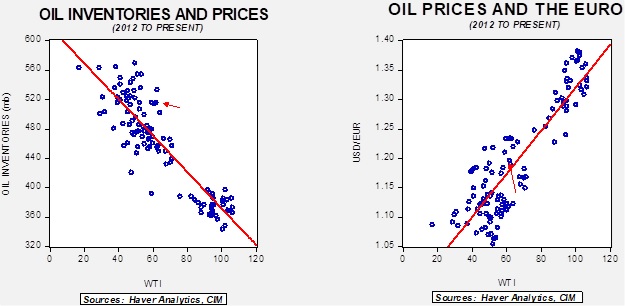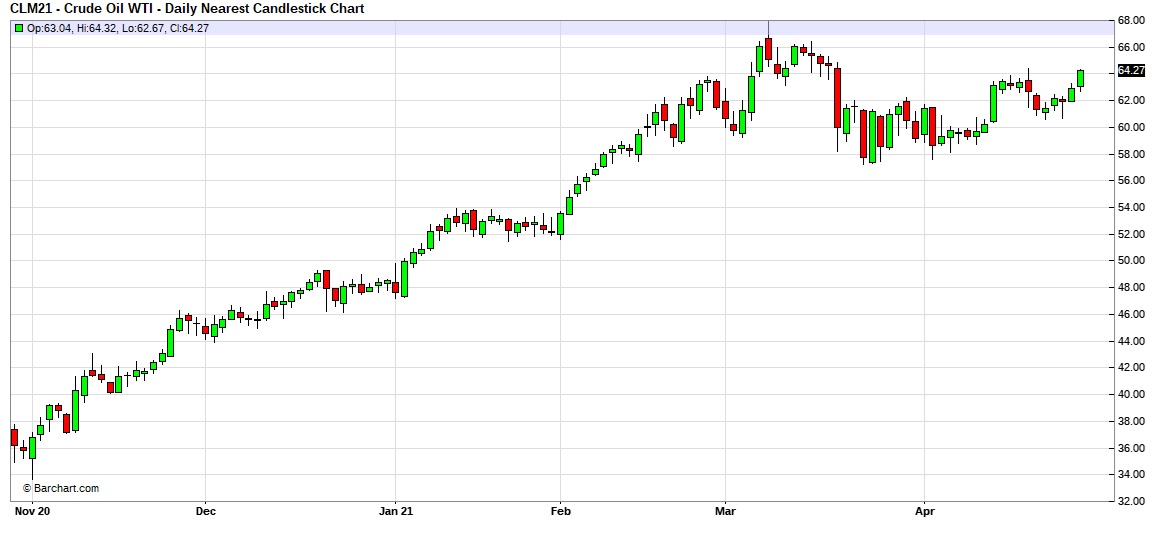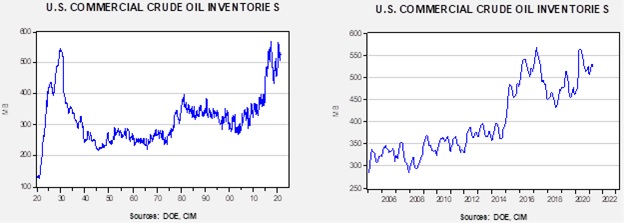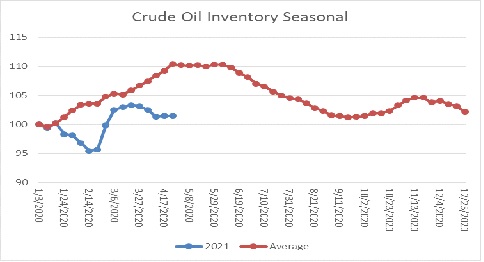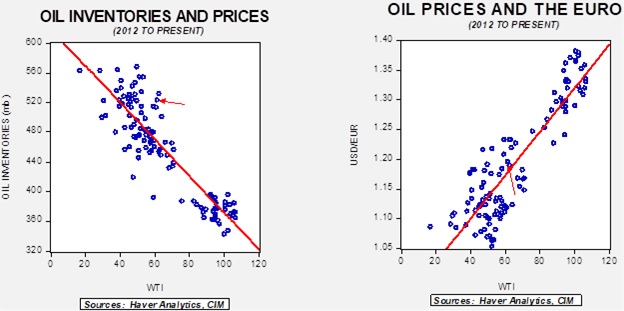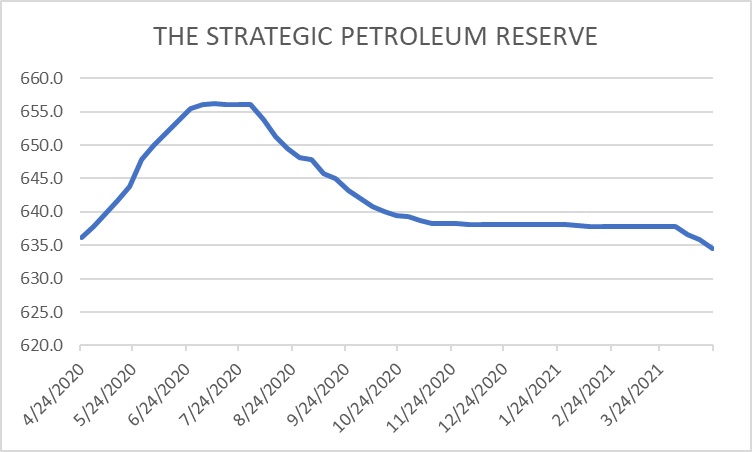by Bill O’Grady, Thomas Wash, and Patrick Fearon-Hernandez, CFA
[Posted: 9:30 AM EDT] | PDF
Today’s Comment opens with key U.S. policy news. The Federal Reserve wraps up its latest policy meeting this afternoon, with no change expected in its massive monetary stimulus program. This evening, President Biden will propose his latest new spending program, but this time with a proposed series of tax hikes to pay for it. We next turn to international news items, including lots of interesting developments in the Middle East. Finally, we present the latest in the coronavirus pandemic.
U.S. Monetary Policy: The Fed will wrap up its latest two-day policy meeting this afternoon. The officials are expected to make no change in the benchmark fed funds interest rate or the central bank’s massive asset purchases, but we will be closely watching the post-meeting press conference for clues about future policy changes. A few things to watch can be found here.
U.S. Fiscal Policy: At a joint session of Congress this evening, President Biden will lay out his third major economic proposal. It follows his $1.9 trillion pandemic relief package, passed into law early this year, and his $2.3 trillion package of spending on infrastructure and other programs that is still working its way through Congress.
- The “American Families Plan” to be presented tonight focuses on measures designed to improve educational outcomes and ease childcare concerns that can make it difficult for women to participate in the workforce. It proposes spending $1.0 trillion over the next decade on child care, education (including universal preschool for 3- and 4-year-olds and two years of tuition-free community college for all Americans), paid leave, and other benefits, in addition to extending tax breaks worth some $800 million over the coming ten years.
- To pay for the new programs, the administration proposes raising the top income-tax rate from 37% to 39.6%. For households making more than $1 million, the plan would also raise the top rate on capital gains and dividends to 39.6% from 20%.
- Including existing payroll and investment taxes—each 3.8%—the top rates on wages and capital gains would reach 43.4%, up from 23.8%.
- The plan would also adjust inheritance taxes. Unrealized gains would be treated as sold and taxable at death, with an exemption of $1 million per person, in addition to the existing exclusion of up to $500,000 for a married couple’s primary residence.
- As we’ve noted before, Republicans and even some Democrats in Congress are expected to push back against the latest proposals. Biden has signaled flexibility, which will probably serve him well and may help get some of his package passed into law, but whatever legislation emerges from the new proposal will probably be much more heavily skewed toward spending than new taxes. To the extent that the final product adds to the current level of fiscal stimulus already in the system, it could help juice the economy further and add to the positive environment for risk assets. However, if Biden has more success than expected regarding tax hikes, it will likely create headwinds for the stock market.
United States-Iran: Following an incident involving Iranian harassment of U.S. Navy ships in the Persian Gulf earlier this month, a U.S. patrol boat was forced on Monday to fire warning shots against three Iranian fast-attack boats swarming and harassing it. One possible theory behind the harassment is that Iranian leaders are testing President Biden’s mettle. They could also be trying to build leverage for the Vienna talks on resuming Iran’s 2015 nuclear deal. Of course, the incidents could also have been touched off by rogue commanders. In any case, the incidents are risky, and an accidental violent confrontation that would roil risk assets and boost oil prices can’t be ruled out.
Saudi Arabia-Iran: Saudi Crown Prince Mohammed bin Salman claimed in a television interview that Saudi Arabia wants to resolve its differences with rival Iran, saying, “At the end of the day, Iran is a neighboring country. All what we ask for is to have a good and distinguished relationship with Iran.” The statement comes just days after the Financial Times revealed that top Saudi and Iranian intelligence officials held secret talks this month in Baghdad in an effort to repair relations between the regional powerhouses. While any rapprochement between the Saudis and the Iranians could help ease geopolitical risks in the Middle East, another important aspect of the story is that it appears to be more evidence that the Biden administration is having significant success in resetting its security relationships around the globe, from repairing or building new alliances against China to reining in longstanding allies who sometimes seemed to get out of control during the Trump administration. It isn’t immediately clear what sticks or carrots Biden is using to pull this off. All the same, a reinvigorated U.S. leadership position in geopolitics could help create a more predictable environment for global investors.
European Union: With the governments of Germany, France, Italy, and Spain ready this week to submit plans for spending their part of the EU’s €750 billion pandemic relief fund, German Finance Minister Scholz and French Finance Minister Le Maire issued a warning that Brussels must approve the plans quickly and get the funds flowing as soon as possible. Otherwise, they warned, the EU would continue to lag behind the rebounding U.S. and Chinese economies.
Brexit: The European Parliament today gave its final approval to the post-Brexit trade deal reached in late December between the U.K. and the EU. Like people around the world, we’re thrilled that we don’t have to think too much about Britain’s exit from the EU anymore! However, we still expect to see a few snarly issues come up between the two sides from time to time, such as the recent ones relating to vaccine shipments and the impact on Northern Ireland.
Russia-Slovakia, et al.: The Russian foreign ministry expelled seven diplomats from Slovakia, Lithuania, Latvia, and Estonia over their countries’ support for the Czech Republic when it recently expelled Russian diplomats over a 2014 spying and sabotage incident.
China: The government is reportedly delaying the release of its 2020 census as it struggles to come to terms with the first apparent Chinese population decline since the famine that accompanied the Great Leap Forward in the late 1950s. The tally is expected to show that the country’s population fell back below 1.4 billion last year, after surpassing that level in 2019.
China-Hong Kong: The Hong Kong municipal government has amended its immigration law in a move that lawyers warn could increase business risks by handing the government broad powers to prevent individuals from leaving the Chinese territory.
COVID-19: Official data show confirmed cases have risen to 148,834,824 worldwide, with 3,138,421 deaths. In the United States, confirmed cases rose to 32,177,167, with 573,383 deaths. Vaccine doses delivered in the U.S. now total 297,543,635, while the number of people who have received at least their first shot totals 141,751,857. Finally, here is the interactive chart from the Financial Times that allows you to compare cases and deaths among countries, scaled by population.
Virology
- Newly confirmed U.S infections totaled just over 50,000 yesterday, compared with the seven-day moving average of 55,272 and the 14-day moving average of 61,197. However, on a less positive note, new deaths related to the virus jumped to 863. At the same time, mass vaccinations continue, and official data indicates 42.7% of U.S. residents have now received at least one shot, and 29.1% are fully vaccinated.
- The CDC issued new guidelines saying people who are fully vaccinated don’t need to wear a facemask when walking, hiking, biking, running alone, or gathering in small groups outside. Officials said they hope the ease in recommendations will encourage more people to get vaccinated.
- According to the revised guidelines, vaccinated people can also dispense with masks when exercising with household members, dining at restaurants outside, and gathering outdoors with small groups that include some unvaccinated people.
- At the same time, the guidelines recommend that fully vaccinated people still wear a mask at indoor gatherings with unvaccinated people and when visiting a barber, hair salon, shopping mall, museum, movie theater, or crowded house of worship, due to lingering concerns that even vaccinated people could potentially transmit COVID-19.
- In New York, Governor Cuomo announced that state mass-vaccination centers will open to walk-ins beginning on Thursday, just as New York City’s centers did last week. The move to walk-ins reflects the impact of rising vaccine supplies as the initial wave of demand moderates.
- In Japan, new infections continue to surge in Tokyo and Osaka, and several other metropolitan areas. Adding to the problems: the government reports that only about 1.1% of the country’s population has been fully vaccinated so far.
- As infections continue to surge in India, driven in part by new mutations, the B.1.617 variant first identified there has now been identified in the U.S. and 18 other countries. In a promising sign, however, Indian scientists said a vaccine developed by the country’s Bharat Biotech proved effective, in a small lab study, against the B.1.617 variant.
- Infections are spreading from India to its neighbors, so the Chinese government is offering vaccine doses and other assistance in a bid to burnish its reputation and increase its influence in the region.
- Finally, in a move that will surely irritate Xi Jinping, the Biden administration is preparing to exert greater influence over the next phase of the World Health Organization’s inquiry into the origins of the pandemic. Experts from the Department of Health and Human Services, the Department of State, the Agriculture Department, and five other federal agencies are reportedly developing action recommendations to be submitted to the WHO for the second phase of the investigation.
- In addition, the administration plans to push back on China’s hypothesis that the virus could have spread via frozen food products, according to people familiar with the work.
- Instead, the experts are expected to urge the release of more data and more testing of animals and humans for early evidence of the new coronavirus, including in parts of southern China where related viruses were previously found.
View PDF



